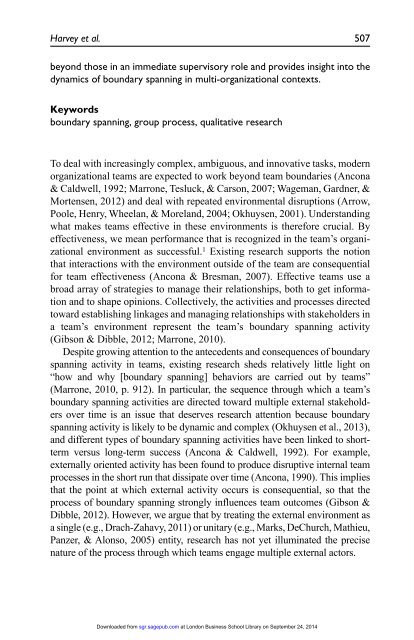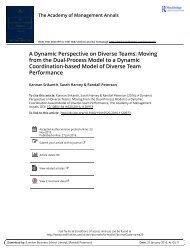The Process of Team Boundary Spanning in Multi-Organizational Contexts - Sarah Harvey, Randall S. Peterson, and N. Anand
Work teams must increasingly operate in complex environments characterized by multiple external actors beyond team and organizational boundaries. Although previous research demonstrates the importance of boundary spanning activities to team effectiveness, it reveals relatively little about the process of boundary spanning in these environments. In this article, we investigated the processes of boundary spanning across multiple external actors in 10 cross-organizational teams. We identified three sequences for reaching out to external actors: (a) moving inside-out from vertical actors inside the host organization to horizontal actors outside of the host organization, (b) moving outside-in from horizontal actors to vertical, and (c) staying-inside with vertical actors from the host organization. Our observations suggest that inside-out and outside-in sequences were more successful than simply pleasing the host organization. We build on our empirical findings to develop a process theory of how team boundary spanning activities across multiple external actors influence team effectiveness. Our research underscores the importance of a team’s interactions with actors in its external environment beyond those in an immediate supervisory role and provides insight into the dynamics of boundary spanning in multi-organizational contexts.
Work teams must increasingly operate in complex environments
characterized by multiple external actors beyond team and organizational
boundaries. Although previous research demonstrates the importance of
boundary spanning activities to team effectiveness, it reveals relatively little
about the process of boundary spanning in these environments. In this article,
we investigated the processes of boundary spanning across multiple external
actors in 10 cross-organizational teams. We identified three sequences for
reaching out to external actors: (a) moving inside-out from vertical actors inside
the host organization to horizontal actors outside of the host organization,
(b) moving outside-in from horizontal actors to vertical, and (c) staying-inside
with vertical actors from the host organization. Our observations suggest
that inside-out and outside-in sequences were more successful than simply
pleasing the host organization. We build on our empirical findings to develop
a process theory of how team boundary spanning activities across multiple
external actors influence team effectiveness. Our research underscores the
importance of a team’s interactions with actors in its external environment beyond those in an immediate supervisory role and provides insight into the
dynamics of boundary spanning in multi-organizational contexts.
You also want an ePaper? Increase the reach of your titles
YUMPU automatically turns print PDFs into web optimized ePapers that Google loves.
<strong>Harvey</strong> et al. 507<br />
beyond those <strong>in</strong> an immediate supervisory role <strong>and</strong> provides <strong>in</strong>sight <strong>in</strong>to the<br />
dynamics <strong>of</strong> boundary spann<strong>in</strong>g <strong>in</strong> multi-organizational contexts.<br />
Keywords<br />
boundary spann<strong>in</strong>g, group process, qualitative research<br />
To deal with <strong>in</strong>creas<strong>in</strong>gly complex, ambiguous, <strong>and</strong> <strong>in</strong>novative tasks, modern<br />
organizational teams are expected to work beyond team boundaries (Ancona<br />
& Caldwell, 1992; Marrone, Tesluck, & Carson, 2007; Wageman, Gardner, &<br />
Mortensen, 2012) <strong>and</strong> deal with repeated environmental disruptions (Arrow,<br />
Poole, Henry, Wheelan, & Morel<strong>and</strong>, 2004; Okhuysen, 2001). Underst<strong>and</strong><strong>in</strong>g<br />
what makes teams effective <strong>in</strong> these environments is therefore crucial. By<br />
effectiveness, we mean performance that is recognized <strong>in</strong> the team’s organizational<br />
environment as successful. 1 Exist<strong>in</strong>g research supports the notion<br />
that <strong>in</strong>teractions with the environment outside <strong>of</strong> the team are consequential<br />
for team effectiveness (Ancona & Bresman, 2007). Effective teams use a<br />
broad array <strong>of</strong> strategies to manage their relationships, both to get <strong>in</strong>formation<br />
<strong>and</strong> to shape op<strong>in</strong>ions. Collectively, the activities <strong>and</strong> processes directed<br />
toward establish<strong>in</strong>g l<strong>in</strong>kages <strong>and</strong> manag<strong>in</strong>g relationships with stakeholders <strong>in</strong><br />
a team’s environment represent the team’s boundary spann<strong>in</strong>g activity<br />
(Gibson & Dibble, 2012; Marrone, 2010).<br />
Despite grow<strong>in</strong>g attention to the antecedents <strong>and</strong> consequences <strong>of</strong> boundary<br />
spann<strong>in</strong>g activity <strong>in</strong> teams, exist<strong>in</strong>g research sheds relatively little light on<br />
“how <strong>and</strong> why [boundary spann<strong>in</strong>g] behaviors are carried out by teams”<br />
(Marrone, 2010, p. 912). In particular, the sequence through which a team’s<br />
boundary spann<strong>in</strong>g activities are directed toward multiple external stakeholders<br />
over time is an issue that deserves research attention because boundary<br />
spann<strong>in</strong>g activity is likely to be dynamic <strong>and</strong> complex (Okhuysen et al., 2013),<br />
<strong>and</strong> different types <strong>of</strong> boundary spann<strong>in</strong>g activities have been l<strong>in</strong>ked to shortterm<br />
versus long-term success (Ancona & Caldwell, 1992). For example,<br />
externally oriented activity has been found to produce disruptive <strong>in</strong>ternal team<br />
processes <strong>in</strong> the short run that dissipate over time (Ancona, 1990). This implies<br />
that the po<strong>in</strong>t at which external activity occurs is consequential, so that the<br />
process <strong>of</strong> boundary spann<strong>in</strong>g strongly <strong>in</strong>fluences team outcomes (Gibson &<br />
Dibble, 2012). However, we argue that by treat<strong>in</strong>g the external environment as<br />
a s<strong>in</strong>gle (e.g., Drach-Zahavy, 2011) or unitary (e.g., Marks, DeChurch, Mathieu,<br />
Panzer, & Alonso, 2005) entity, research has not yet illum<strong>in</strong>ated the precise<br />
nature <strong>of</strong> the process through which teams engage multiple external actors.<br />
Downloaded from sgr.sagepub.com at London Bus<strong>in</strong>ess School Library on September 24, 2014
















